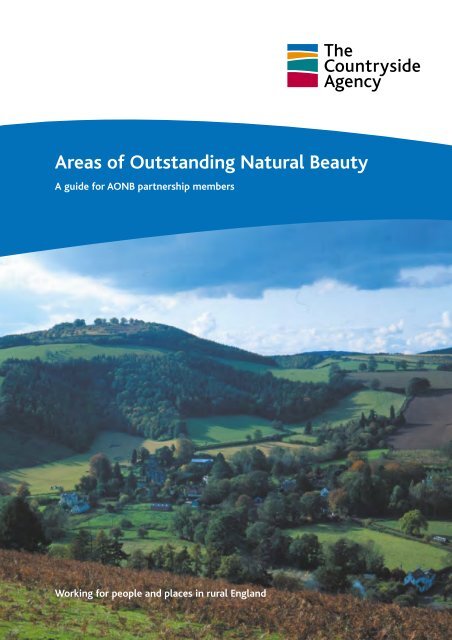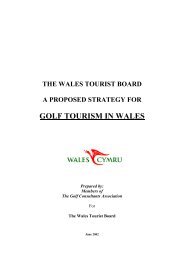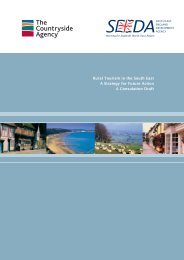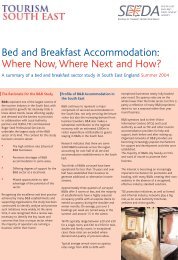Areas of Outstanding Natural Beauty - Publications and products
Areas of Outstanding Natural Beauty - Publications and products
Areas of Outstanding Natural Beauty - Publications and products
Create successful ePaper yourself
Turn your PDF publications into a flip-book with our unique Google optimized e-Paper software.
<strong>Areas</strong> <strong>of</strong> <strong>Outst<strong>and</strong>ing</strong> <strong>Natural</strong> <strong>Beauty</strong><br />
A guide for AONB partnership members<br />
Working for people <strong>and</strong> places in rural Engl<strong>and</strong>
The Countryside Agency<br />
The Countryside Agency is the statutory body working:<br />
• to conserve <strong>and</strong> enhance Engl<strong>and</strong>’s countryside;<br />
• to spread social <strong>and</strong> economic opportunity for the people who<br />
live there;<br />
• to help everyone, wherever they live <strong>and</strong> whatever their<br />
background, to enjoy the countryside <strong>and</strong> share in this priceless<br />
national asset.<br />
The Countryside Agency will work to achieve the very best for the<br />
English countryside – its people <strong>and</strong> places, by:<br />
• influencing those whose decisions affect the countryside through<br />
our expertise, our research <strong>and</strong> by spreading good practice by<br />
showing what works;<br />
• implementing specific work programmes reflecting priorities set by<br />
Parliament, the Government <strong>and</strong> the Agency Board.<br />
To find out more about our work, <strong>and</strong> for information about the<br />
countryside, visit our website: www.countryside.gov.uk<br />
The Countryside Agency publications catalogue (CA2) includes a<br />
full listing <strong>of</strong> all our publications. Contact Countryside Agency<br />
<strong>Publications</strong> for a free copy.<br />
Cover photograph: Shropshire Hills AONB. CA/David Woodfall
<strong>Areas</strong> <strong>of</strong> <strong>Outst<strong>and</strong>ing</strong> <strong>Natural</strong> <strong>Beauty</strong><br />
A guide for AONB partnership members<br />
Distributed by:<br />
Countryside Agency <strong>Publications</strong><br />
PO Box 125<br />
Wetherby<br />
West Yorkshire LS23 7EP<br />
Telephone 0870 120 6466<br />
Fax 0870 120 6467<br />
Email countryside@twoten.press.net<br />
Minicom 0870 120 7405 (for the hard <strong>of</strong> hearing)<br />
www.countryside.gov.uk<br />
© Countryside Agency<br />
CA 24<br />
November 2001
A guide for AONB partnership members<br />
Foreword<br />
<strong>Areas</strong> <strong>of</strong> <strong>Outst<strong>and</strong>ing</strong> <strong>Natural</strong> <strong>Beauty</strong> have a special place amongst the<br />
protected l<strong>and</strong>scapes <strong>of</strong> Engl<strong>and</strong>. Their care has been entrusted to the<br />
local authorities, organisations, community groups <strong>and</strong> the individuals<br />
who live <strong>and</strong> work within them: or who value them. We have relied on<br />
them to manage those l<strong>and</strong>scapes for the benefit <strong>of</strong> the nation as a<br />
whole. It has not been easy task but the success is clear in the<br />
outst<strong>and</strong>ing quality <strong>of</strong> the countryside that makes up our AONBs: our<br />
finest countryside.<br />
However, since 1957 when the first English AONB was designated,<br />
the Quantock Hills, there has been massive change in the English<br />
countryside. New legislation, the Countryside <strong>and</strong> Rights <strong>of</strong> Way Act<br />
2000, provides the basis for a new management framework to reflect<br />
the current challenges.<br />
The new management framework recognises <strong>and</strong> retains, the best <strong>of</strong><br />
the old system – local care. It allows those local systems <strong>and</strong> people to<br />
further the conservation <strong>and</strong> enhancement <strong>of</strong> their AONBs. The setting<br />
up <strong>of</strong> local partnerships, the employment <strong>of</strong> AONB staff <strong>and</strong> the<br />
production <strong>of</strong> AONB Management Plans will allow AONBs to flourish.<br />
These mechanisms should inspire l<strong>and</strong> managers <strong>and</strong> others. In that<br />
way our finest l<strong>and</strong>scapes will not only be protected, but enhanced for<br />
the future. They will <strong>of</strong>fer opportunities for people to enjoy them <strong>and</strong><br />
benefit from them: environmentally, socially <strong>and</strong> economically.<br />
This guide has been written to help AONB partnerships come<br />
together to meet the challenges <strong>of</strong> 21st century protected l<strong>and</strong>scape<br />
management. It gives an introduction to the puposes <strong>of</strong> AONB<br />
designation, the laws that protect them <strong>and</strong> the partnership role in<br />
ensuring that these l<strong>and</strong>scapes continue to flourish. These are<br />
undoubtedly exiting times for AONBs: those <strong>of</strong> you involved in local<br />
AONB partnerships have real opportunities to make a difference to our<br />
finest countryside. Most importantly, you have the chance to deliver<br />
real outcomes, real work on the ground <strong>and</strong> a real future for Engl<strong>and</strong>’s<br />
finest countryside.<br />
Ewen Cameron<br />
Chairman<br />
The Countryside Agency<br />
2
A guide for AONB partnership members<br />
Contents<br />
Foreword 2<br />
1. Introduction 4<br />
What is an Area <strong>of</strong> <strong>Outst<strong>and</strong>ing</strong> <strong>Natural</strong> <strong>Beauty</strong>? 6<br />
What does AONB designation do? 7<br />
Who looks after AONBs? 7<br />
What does legislation say about AONBs? 8<br />
What about planning <strong>and</strong> development control? 10<br />
How can AONBs be protected <strong>and</strong> managed? 12<br />
What should an AONB partnership do? 16<br />
What are the roles <strong>of</strong> AONB partnership members? 17<br />
Why is the AONB Management Plan important? 19<br />
2. The management <strong>of</strong> AONBs 22<br />
What should an AONB staff unit do? 22<br />
How can a staff unit be structured? 23<br />
How is AONB management funded? 24<br />
What will be the outcomes <strong>of</strong> AONB management: 25<br />
how can its effectiveness be measured?<br />
3. The wider context 27<br />
How can the national Association for AONBs help? 27<br />
What about the international context? 27<br />
3
A guide for AONB partnership members<br />
1.Introduction<br />
This is a guide to what an Area <strong>of</strong> <strong>Outst<strong>and</strong>ing</strong> <strong>Natural</strong> <strong>Beauty</strong> (AONB) is<br />
<strong>and</strong> how it should be cared for. It is an update on the 1994 Countryside<br />
Commission document ‘<strong>Areas</strong> <strong>of</strong> <strong>Outst<strong>and</strong>ing</strong> <strong>Natural</strong> <strong>Beauty</strong>: A Guide for<br />
Members <strong>of</strong> Joint Advisory Committees’ (CCP 461). It gives background<br />
information on the designation <strong>and</strong> purposes <strong>of</strong> AONBs <strong>and</strong> the<br />
responsibilities that local authorities <strong>and</strong> others have for their management.<br />
It provides up to date information on the new statutory arrangements for<br />
AONBs, bought in as part <strong>of</strong> the Countryside <strong>and</strong> Rights <strong>of</strong> Way Act 2000<br />
<strong>and</strong> most importantly, it gives advice on how to achieve action on the<br />
ground to conserve <strong>and</strong> enhance AONBs.<br />
The guide is aimed at all organisations <strong>and</strong> individuals who have an<br />
interest in protected l<strong>and</strong>scapes <strong>and</strong> who want to do more to manage <strong>and</strong><br />
enhance these nationally important areas: in particular those who serve on<br />
the partnerships which manage each AONB.<br />
The AONBs in Engl<strong>and</strong> <strong>and</strong> Wales are our finest l<strong>and</strong>scapes.They are<br />
places that have been regarded for generations as treasured areas with<br />
special character <strong>and</strong> are designated, alongside our National Parks, to mark<br />
them out for special protection <strong>and</strong> management.They include the rolling<br />
limestone hills <strong>of</strong> the Cotswolds <strong>and</strong> chalk downs <strong>of</strong> North Wessex; the high<br />
moorl<strong>and</strong>s <strong>of</strong> the Forest <strong>of</strong> Bowl<strong>and</strong> <strong>and</strong> the North Pennines; the wetl<strong>and</strong>s<br />
<strong>and</strong> heaths <strong>of</strong> the Norfolk <strong>and</strong> Suffolk coasts; <strong>and</strong> the hills <strong>and</strong> estuaries <strong>of</strong><br />
South Devon.They are designated as protected l<strong>and</strong>scapes by law, to make<br />
sure that the features that make them special are maintained for future<br />
generations.<br />
The 41 AONBs cover over 15% <strong>of</strong> the l<strong>and</strong> area <strong>of</strong> Engl<strong>and</strong> <strong>and</strong> Wales.<br />
They are inhabited by thous<strong>and</strong>s <strong>of</strong> people <strong>and</strong> visited by many more.The<br />
Countryside <strong>and</strong> Rights <strong>of</strong> Way (CRoW) Act 2000 significantly raised the<br />
pr<strong>of</strong>ile <strong>of</strong> AONBs by placing new responsibilities on the local authorities<br />
<strong>and</strong> conservation boards who are responsible for their management,<br />
including a statutory duty to produce <strong>and</strong> regularly review AONB<br />
Management Plans for their areas <strong>and</strong> a duty on all ‘relevant authorities’ to<br />
have regard for AONB purposes.<br />
Given the diverse range <strong>of</strong> duties <strong>and</strong> responsibilities, the management<br />
<strong>of</strong> an AONB is a complex activity. Current practice varies widely from<br />
authority to authority. The majority <strong>of</strong> AONBs have published l<strong>and</strong>scape<br />
assessments <strong>and</strong> management plans, <strong>and</strong> many have formal partnerships <strong>and</strong><br />
AONB staff units to ensure the plans are implemented. Yet there is very little<br />
guidance available on what local authorities <strong>and</strong> partner organisations have<br />
to do to manage them properly. This guide aims to begin to fill that gap.<br />
It is complementary to AONB Management Plans: A guide (CA23)<br />
published by the Countryside Agency. This guide gives technical<br />
information <strong>of</strong> how to prepare <strong>and</strong> produce a Management Plan for an<br />
AONB, the new statutory requirement under the CRoW Act 2000.<br />
4
A guide for AONB partnership members<br />
What is an Area <strong>of</strong> <strong>Outst<strong>and</strong>ing</strong> <strong>Natural</strong> <strong>Beauty</strong>?<br />
There is a huge variety <strong>of</strong> scenery <strong>and</strong> l<strong>and</strong>scapes in Engl<strong>and</strong> <strong>and</strong> Wales<br />
from flat coasts to craggy mountains. The l<strong>and</strong>scapes considered to be<br />
the most valuable are designated as National Parks or AONBs. These are<br />
l<strong>and</strong>scapes that are protected <strong>and</strong> managed by law to maintain their<br />
special character for now, <strong>and</strong> for future generations. A leaflet <strong>and</strong><br />
map has been produced highlighting the diversity <strong>of</strong> Engl<strong>and</strong>’s<br />
protected l<strong>and</strong>scapes 1 .<br />
The Countryside Agency is now responsible for designating AONBs<br />
under the CRoW Act 2000: designation defines the area to which<br />
special measures shall apply. Over 20,000 square kilometres <strong>of</strong> l<strong>and</strong> in<br />
Engl<strong>and</strong> <strong>and</strong> Wales are designated, amounting to 15.6% <strong>of</strong> total l<strong>and</strong><br />
area. The purpose <strong>of</strong> designation as an AONB is to conserve <strong>and</strong><br />
enhance the natural beauty (which includes wildlife <strong>and</strong> cultural<br />
heritage as well as scenery) <strong>of</strong> the area. Designation gives a formal<br />
statutory recognition to an area’s national importance. Local<br />
government must formally state its policies towards AONB purposes<br />
through a ‘Management Plan’; special l<strong>and</strong> use planning <strong>and</strong><br />
development policies apply; <strong>and</strong> other public authorities must<br />
demonstrate their commitment to AONBs by having regard to<br />
AONB purposes.<br />
The designation helps to protect not just the natural features – the<br />
trees, fields <strong>and</strong> open spaces – but also settlements <strong>and</strong> working<br />
environments that are unique characteristics <strong>of</strong> the countryside. The<br />
designation allows for the development <strong>of</strong> communities <strong>and</strong> economic<br />
activity, including rural businesses, in ways that further enhance the<br />
character <strong>of</strong> the AONB.<br />
The l<strong>and</strong>scapes <strong>of</strong> the AONBs in Engl<strong>and</strong> <strong>and</strong> Wales include<br />
mountains <strong>and</strong> hills, forests, valleys <strong>and</strong> river estuaries. ‘<strong>Natural</strong> <strong>Beauty</strong>’<br />
is not just the look <strong>of</strong> the l<strong>and</strong>scape, but includes l<strong>and</strong>form <strong>and</strong><br />
geology, plants <strong>and</strong> animals, l<strong>and</strong>scape features <strong>and</strong> the rich history <strong>of</strong><br />
human settlement over the centuries. The character <strong>of</strong> AONB l<strong>and</strong>scapes<br />
has been created <strong>and</strong> maintained by human activity over the last 5000<br />
years It is crucial therefore to sustain communities within the AONBs,<br />
so that this essential stewardship can continue. Their support is also<br />
needed when inappropriate development <strong>and</strong> other pressures threaten<br />
the AONBs character. The cooperation <strong>of</strong> people, especially farmers <strong>and</strong><br />
l<strong>and</strong> owners <strong>and</strong> those involved in local industry <strong>and</strong> commerce, is<br />
vital to the protection <strong>of</strong> the AONBs. Because they are attractive areas<br />
they are also popular for leisure <strong>and</strong> tourism <strong>and</strong> increasingly need to<br />
be managed for recreation as well as conservation.<br />
1. Our finest countryside: Engl<strong>and</strong>’s protected<br />
l<strong>and</strong>scapes, 2001, CA18, The Countryside Agency.<br />
6
A guide for AONB partnership members<br />
What does AONB designation do?<br />
Designation gives a formal statutory recognition to the importance <strong>of</strong><br />
these high quality l<strong>and</strong>scapes. Special guidance on planning <strong>and</strong><br />
development control is given via Planning Policy Guidance (PPG)<br />
notes 2 .The designation requires local authorities to devise strategies <strong>and</strong><br />
plans for AONB management <strong>and</strong> encourages them to set up<br />
mechanisms for action. It also empowers local authorities to carry out<br />
management specifically to conserve <strong>and</strong> enhance the AONB, in line<br />
with its purposes. Most AONB management though needs to be done by<br />
encouragement <strong>and</strong> incentive, not by regulation, <strong>and</strong> by working closely<br />
<strong>and</strong> positively with authorities, organisations <strong>and</strong> interest groups.<br />
The purpose <strong>of</strong> designation – to conserve <strong>and</strong> enhance natural<br />
beauty – reflects the need for integrated action – helping to conserve<br />
the l<strong>and</strong>scape through sustainable forms <strong>of</strong> environmental, social <strong>and</strong><br />
economic development. Integrated management can tackle a wide range<br />
<strong>of</strong> issues that impact on the countryside by prioritising action. AONB<br />
designation does not mean that the area is to be preserved with no<br />
development or change being allowed, but instead requires conservation<br />
<strong>and</strong> enhancement. What is important is to underst<strong>and</strong> what makes an<br />
AONB special <strong>and</strong> develop a vision <strong>of</strong> how it should be sustained.This<br />
means encouraging some activities <strong>and</strong> minimising others.<br />
Purposes <strong>of</strong> AONB designation 3<br />
• The primary purpose <strong>of</strong> AONB designation is to conserve <strong>and</strong> enhance natural beauty.<br />
• In pursuing the primary purpose account should be taken <strong>of</strong> the needs <strong>of</strong> agriculture, forestry, other rural industries <strong>and</strong> <strong>of</strong> the<br />
economic <strong>and</strong> social needs <strong>of</strong> local communities. Particular regard should be paid to promoting sustainable forms <strong>of</strong> social <strong>and</strong><br />
economic development that in themselves conserve <strong>and</strong> enhance the environment.<br />
• Recreation is not an objective <strong>of</strong> designation, but the dem<strong>and</strong> for recreation should be met so far as this is consistent with the<br />
conservation <strong>of</strong> natural beauty <strong>and</strong> the needs <strong>of</strong> agriculture, forestry <strong>and</strong> other uses.<br />
2. Planning Policy Guidance Note Number 7:<br />
The Countryside - Environmental Quality <strong>and</strong><br />
Economic <strong>and</strong> Social Development, 1997,<br />
Department for Transport, Local Government<br />
<strong>and</strong> the Regions.<br />
3. AONBs: A policy statement, 1991, CCP 356,<br />
Countryside Commission.<br />
Who looks after AONBs?<br />
AONBs <strong>and</strong> National Parks are protected l<strong>and</strong>scapes <strong>and</strong> need to be<br />
protected from inappropriate development. They also need positive <strong>and</strong><br />
pro-active management to address the many pressures upon them.<br />
These pressures include urban development, transport infrastructure<br />
<strong>and</strong> traffic growth, changes farming practices <strong>and</strong> l<strong>and</strong> management,<br />
recreational use <strong>and</strong>, in the long term, potential climate change.<br />
Protected l<strong>and</strong>scapes need effective administrative arrangements <strong>and</strong><br />
adequate funding to tackle these pressures <strong>and</strong> to devise management<br />
strategies to protect, <strong>and</strong> allow activities that will enhance the<br />
l<strong>and</strong>scape in the longer term.<br />
L<strong>and</strong> in AONBs, like National Parks, is largely privately owned. Most<br />
<strong>of</strong> the l<strong>and</strong> is used for agriculture <strong>and</strong> l<strong>and</strong>owners <strong>and</strong> farmers are<br />
generally free to decide how they use the l<strong>and</strong>. However, the<br />
7
A guide for AONB partnership members<br />
Countryside Agency <strong>and</strong> many local authorities have recognised the<br />
need to tackle management issues in AONBs <strong>and</strong> in most areas have<br />
established partnerships <strong>and</strong> staff units to help protect them <strong>and</strong> use<br />
their various powers to deliver action.<br />
The Countryside Agency strategy set out its polices for National Parks <strong>and</strong> AONBs in 2001.<br />
Its principles are as follows:<br />
• Engl<strong>and</strong>’s finest l<strong>and</strong>scapes should be marked out by designations <strong>and</strong> protected <strong>and</strong> managed accordingly.<br />
• Our approach in National Parks <strong>and</strong> AONBs will be different, reflecting the special role <strong>of</strong> National Parks in providing outst<strong>and</strong>ing<br />
recreational opportunities.<br />
• All National Parks <strong>and</strong> AONBs should have management structures, policies <strong>and</strong> resources reflecting their particular characteristics.<br />
Governance should respect local circumstances but operate in the national interest.<br />
• Finest l<strong>and</strong>scapes cannot be managed in isolation, but should reflect <strong>and</strong> serve their wider local <strong>and</strong> regional settings.<br />
• Management should reflect best practice <strong>and</strong> provide an example <strong>of</strong> sustainable development for other parts <strong>of</strong> the countryside;<br />
finest l<strong>and</strong>scapes can act as test beds for innovative approaches.<br />
What does legislation say about AONBs?<br />
The National Parks <strong>and</strong> Access to the Countryside Act 1949 was the<br />
first piece <strong>of</strong> relevant legislation which provided for the designation <strong>of</strong><br />
AONBs. This legislation provided for planning protection <strong>of</strong> AONBs <strong>and</strong><br />
gave local authorities the power to take action to conserve them. But<br />
no statutory duties were place on local authorities or any other body.<br />
Since then, however, the pressures on the l<strong>and</strong>scape <strong>of</strong> our protected<br />
areas have increased dramatically <strong>and</strong> the provisions <strong>of</strong> the 1949 Act<br />
are now inadequate.<br />
The Environment Act 1995 bought in new measures for the<br />
protection <strong>of</strong> National Parks: The CRoW Act 2000 has now done the<br />
same for AONBs.<br />
The Countryside <strong>and</strong> Rights <strong>of</strong> Way (CRoW) Act 2000:<br />
• Consolidates <strong>and</strong> strengthens earlier legislation concerning AONBs, reaffirming the purposes <strong>of</strong> designation, <strong>and</strong> confirming the<br />
powers <strong>of</strong> local authorities to take appropriate action to conserve or enhance the natural beauty <strong>of</strong> AONBs.<br />
In addition the Act:<br />
• Places a duty on all public bodies <strong>and</strong> statutory undertakers to ‘have regard’ to the purposes <strong>of</strong> AONBs.<br />
• Establishes a process for creating AONB conservation boards.<br />
• Creates a statutory responsibility for local authorities <strong>and</strong> conservation boards to produce <strong>and</strong> regularly to review AONB Management Plans.<br />
The new legislation in the CRoW Act marks a significant raising <strong>of</strong><br />
the AONB status <strong>and</strong> confirm their importance in government policy.<br />
The CRoW Act has altered the context within which AONBs are<br />
managed. Some <strong>of</strong> the changes, including provisions giving the public<br />
access to open country, amendments to legislation on rights <strong>of</strong> way <strong>and</strong><br />
greater protection for wildlife <strong>and</strong> natural features, apply to the<br />
8
A guide for AONB partnership members<br />
countryside as a whole. Part IV <strong>of</strong> the Act relates specifically to AONBs.<br />
The CRoW Act reaffirms the purposes <strong>of</strong> AONB designation <strong>and</strong><br />
confirms the powers <strong>of</strong> local authorities to take appropriate action to<br />
conserve or enhance the natural beauty <strong>of</strong> AONBs. It also places a new<br />
statutory duty on local authorities to prepare <strong>and</strong> publish a Management<br />
Plan for the AONB which sets out their policies for managing the AONB<br />
<strong>and</strong> for carrying our their functions in relation to it. New Plans must be<br />
prepared by April 2004 <strong>and</strong> then reviewed every five years.<br />
There is another important provision that places a duty on all<br />
‘relevant authorities’ to have regard for the purposes <strong>of</strong> conserving <strong>and</strong><br />
enhancing the AONB: ‘relevant authorities’ includes any public body<br />
(e.g. a government department or agency) <strong>and</strong> any statutory undertaker<br />
(e.g. water companies). This part <strong>of</strong> the Act opens the door to many<br />
people <strong>and</strong> organisations getting involved in AONB management that<br />
the AONBs have not always with engaged before.<br />
The Act also allows for the Secretary <strong>of</strong> State to establish, after<br />
consultation with local authorities, new management arrangements for<br />
AONBs in the form <strong>of</strong> a ‘conservation board’. Conservation boards will<br />
not be appropriate for all AONBs but may be needed for the larger,<br />
more administratively complex AONBs where there is a range <strong>of</strong> issues<br />
which can best be addressed by an independent body with its own<br />
executive powers to act directly. Where these independent bodies have<br />
been established, they will carry out the duty to prepare Management<br />
Plans <strong>and</strong> will act to manage the AONB.<br />
The opportunity to establish conservation boards, the requirement to<br />
produce Management Plans <strong>and</strong> the duty <strong>of</strong> public bodies to have regard<br />
to AONB purposes all have significant implications for AONB management.<br />
Conservation boards<br />
The CRoW Act enables the Secretary <strong>of</strong> State to establish conservation boards to manage AONBs. Conservation boards:<br />
• will only be established only if the majority <strong>of</strong> the local authorities in the AONB agree;<br />
• will be made up <strong>of</strong> at least 40% local authority members, at least 20% parish council members <strong>and</strong> 40% Secretary <strong>of</strong> State<br />
appointees: the number <strong>of</strong> members <strong>and</strong> range <strong>of</strong> expertise desirable will be defined for each;<br />
• will take on the responsibility for producing the Management Plan from the local authorities;<br />
• must have regard to two purposes: to conserve <strong>and</strong> enhance the natural beauty <strong>of</strong> the AONB <strong>and</strong> increase public underst<strong>and</strong>ing <strong>and</strong><br />
enjoyment <strong>of</strong> the special qualities <strong>of</strong> the AONB, with greater weight on the first if there is a conflict. It must also seek to foster<br />
economic <strong>and</strong> social well being whilst pursuing these two purposes;<br />
• will have general powers to act in pursuit <strong>of</strong> these purposes. Appropriate powers may also be transferred from, or shared with, local<br />
authorities. Planning <strong>and</strong> development control functions however will remain with local authorities.<br />
9
A guide for AONB partnership members<br />
National Parks <strong>and</strong> AONBs<br />
National Parks <strong>and</strong> AONBs have their origins in the same movements to protect the countryside <strong>and</strong> were both designated under the<br />
National Parks <strong>and</strong> Access to the Countryside Act 1949. Both have equal importance in l<strong>and</strong>scape quality terms; both are designated to<br />
conserve <strong>and</strong> enhance natural beauty. Both have the same level <strong>of</strong> protection in planning policy. Also, like National Parks, public bodies<br />
etc. must contribute to AONB management by having regard for AONB purposes. However, there is a distinct differences in the purposes<br />
<strong>and</strong> reasons for designation in relation to recreation. National Parks have an additional purpose to promote opportunities for people to<br />
underst<strong>and</strong> <strong>and</strong> enjoy their special qualities.<br />
Management is also different, National Parks have their own National Park Authorities, which are local authorities in their own right<br />
<strong>and</strong> have their own planning, development control functions <strong>and</strong> other executive powers. They receive funds directly from central<br />
government <strong>and</strong> can precept funds from local authorities. AONBs are largely managed as part <strong>of</strong> their general duties by local authorities:<br />
or in some cases conservation boards.<br />
What about planning <strong>and</strong> development control?<br />
The town <strong>and</strong> country planning system has a major role in influencing<br />
l<strong>and</strong>scape character <strong>and</strong> diversity. It plans for the use <strong>of</strong> l<strong>and</strong> <strong>and</strong><br />
controls where certain types <strong>of</strong> development should take place.<br />
Planning authorities (county, district <strong>and</strong> unitary councils) must<br />
include policies in development plans that favour the conservation <strong>of</strong><br />
the natural beauty <strong>and</strong> character <strong>of</strong> AONBs. Their development control<br />
decisions should follow these policies <strong>and</strong> provide AONBs with a<br />
framework that integrates social, environmental <strong>and</strong> economic factors<br />
to allow for the conservation <strong>and</strong> enhancement <strong>of</strong> the AONB in the<br />
longer term.<br />
Planning<br />
The Countryside Agency’s policy on planning in the countryside 4 includes the vision:<br />
We want to pass on to future generations the sort <strong>of</strong> development which will help make<br />
their livelihoods <strong>and</strong> l<strong>and</strong>scapes as good as we enjoy; <strong>and</strong> we want to pass it on with pride.<br />
We also seek a countryside which is rich in natural beauty, biodiversity <strong>and</strong> character.<br />
4. Planning tomorrow’s countryside, 2000, CA 60,<br />
The Countryside Agency.<br />
AONB designation is not about stopping development, but it<br />
encourages development to be approached with special care. Poorly<br />
designed, or located development can spoil the character <strong>of</strong> an area,<br />
but some development can have great social <strong>and</strong> economic benefits for<br />
the community which can further AONB aims in the long term.<br />
10
A guide for AONB partnership members<br />
National government planning policy guidelines on AONBs<br />
The planning policy guidance to local authorities from national government (Planning Policy Guidance 7; 5 paragraph 4.8 )<br />
states that:<br />
“In general policies <strong>and</strong> development control decisions affecting AONBs should favour conservation <strong>of</strong> the natural beauty <strong>of</strong> the<br />
l<strong>and</strong>scape. In all cases the environmental effects <strong>of</strong> the new proposals will be a major consideration, though it will also be appropriate<br />
to have regard to the economic <strong>and</strong> social well being <strong>of</strong> the areas. In would normally be inconsistent with the aims <strong>of</strong> designation to<br />
permit the siting <strong>of</strong> major industrial or commercial development in these areas. Only proven national interest <strong>and</strong> lack <strong>of</strong> alternative<br />
sites can justify an exception.”<br />
The Guidance is being revised to make it even clearer that AONBs should have the same high level <strong>of</strong> protection as National Parks.<br />
A Ministerial statement said:<br />
“ The Government accept ........ that the l<strong>and</strong>scape qualities <strong>of</strong> National Parks <strong>and</strong> <strong>Areas</strong> <strong>of</strong> <strong>Outst<strong>and</strong>ing</strong> <strong>Natural</strong> <strong>Beauty</strong> (AONBs) are<br />
equivalent. Conserving <strong>and</strong> enhancing the beauty <strong>of</strong> the l<strong>and</strong>scape are objectives for both types <strong>of</strong> designation. The Government<br />
therefore believe that the protection given to both types <strong>of</strong> area by the l<strong>and</strong> use planning system should also be equivalent.” 6<br />
5. Planning Policy Guidance Note Number 7:<br />
The Countryside - Environmental Quality <strong>and</strong><br />
Economic <strong>and</strong> Social Development, 1997,<br />
Department for Transport, Local Government<br />
<strong>and</strong> the Regions.<br />
In all AONBs major development should be regarded as inconsistent<br />
with the aims <strong>of</strong> development. Schemes for major roads, motorways,<br />
large building developments <strong>and</strong> mineral workings should be avoided.<br />
Authorities should also consider the issue <strong>of</strong> the impact <strong>of</strong> a number <strong>of</strong><br />
developments in the long term, or cumulative impacts, <strong>and</strong> make<br />
policies accordingly. Small-scale developments, particularly if they are<br />
essential to the needs <strong>of</strong> the local community, are normally acceptable<br />
<strong>and</strong> should be within, or close to, existing towns <strong>and</strong> villages <strong>and</strong> be in<br />
sympathy with the character <strong>of</strong> the area. Good planning in AONBs<br />
should look to add value through development <strong>and</strong> ensure, for<br />
example, good design on all new houses.<br />
Local authority planning policy should not be limited to what is<br />
within the AONB boundary. Inappropriate development outside the<br />
boundary may have an adverse impact on the l<strong>and</strong>scape within it.<br />
Conversely, certain planning controls outside the boundary may expose<br />
areas within the boundary to damaging development.<br />
Local authorities are responsible for planning <strong>and</strong> development<br />
control in AONBs; <strong>and</strong> need to include appropriate policies in their<br />
structure <strong>and</strong> local plans. AONB partnerships should, however, <strong>of</strong>fer<br />
advice on planning matters which affect the AONB. They play an<br />
important role in ensuring that the proper protection is given to the<br />
AONB, <strong>and</strong> also that planning policies contribute positively to<br />
conservation <strong>and</strong> enhancement <strong>of</strong> the AONB. They should be a<br />
consultee on strategic policies <strong>and</strong> on planning cases which affect the<br />
AONB. They can help ensure common <strong>and</strong> high st<strong>and</strong>ards across the<br />
area, where the AONB falls within several local authorities <strong>and</strong> can<br />
<strong>of</strong>fer generic advice on planning matters. For example – they may<br />
produce an AONB Design Guide which can be adopted by all local<br />
planning authorities as Supplementary Planning Guidance.<br />
6. Nick Raynsford’s (planning minister) response<br />
to a parliamentary question in June, 2000.<br />
11
A guide for AONB partnership members<br />
From the Wye Valley JAC Members Guide 7 :<br />
Development control<br />
A. It is very important that:<br />
• development control policies <strong>and</strong> decisions are sensitive to AONB objectives;<br />
• policies are coordinated across local authority boundaries.<br />
B. A key task for the JAC is to advise planning authorities in the preparation <strong>of</strong> their structure, local or unitary development plans to<br />
ensure the interests <strong>of</strong> the AONB are safeguarded.<br />
C. The AONB <strong>of</strong>ficer should be consulted by the appropriate planning authority on development proposals likely to have significant<br />
impact on the AONB.<br />
D. The aim is to ensure:<br />
• the scale, nature <strong>and</strong> quality <strong>of</strong> development is compatible with the AONB Management Plan objectives;<br />
• development contributes to the l<strong>and</strong>scape, rather than detracting from it;<br />
• development reflects local vernacular styles where possible.<br />
7. A H<strong>and</strong>book for Members <strong>of</strong> the Wye Valley<br />
AONB Joint Advisory Committee <strong>and</strong> Supporting<br />
Technical Officers, 1998, unpublished.<br />
How can AONBs be protected <strong>and</strong> managed?<br />
Local authorities are responsible for preparing <strong>and</strong> publishing<br />
management plans for AONBs <strong>and</strong> have powers to carry out necessary<br />
management. However, they are not solely responsible for caring for<br />
AONBs. Partnerships are a valuable means <strong>of</strong> coordinating the<br />
management <strong>of</strong> areas <strong>of</strong> countryside in multiple ownership. They bring<br />
together interested parties <strong>and</strong> encouraging a strong sense <strong>of</strong><br />
‘ownership’ to care for the area. AONB partnerships are <strong>of</strong>ten set up as<br />
local authority Joint Advisory Committees (JACs), some have been<br />
established as a conference, forum, trust or, as a joint local government<br />
committee. There can now also be statutory conservation boards since<br />
the CRoW Act.<br />
Most AONBs already have a partnership structure in place. Many<br />
have also set up a support network <strong>of</strong> working groups, advisory panels<br />
<strong>and</strong> staff units to allow the partnership to function effectively as an<br />
AONB decision making <strong>and</strong> implementation body. These groups<br />
prepare reports <strong>and</strong> make recommendations to the partnership <strong>and</strong><br />
take on much <strong>of</strong> its day-to-day operation.<br />
Action at a local level is most successful if it involves many<br />
organisations that have an interest in the area. It should also involve the<br />
community – those people who live <strong>and</strong> work in, or near, the area <strong>and</strong><br />
who may also depend on the area for their livelihoods. By setting up<br />
partnerships that involve local <strong>and</strong> national government, relevant<br />
organisations <strong>and</strong> interest groups <strong>and</strong> the community, local authorities<br />
can multiply their effect on conservation <strong>and</strong> enhancement, <strong>and</strong> help<br />
to make sure action is sustainable. AONBs can become exemplars <strong>of</strong><br />
good practice by demonstrating the benefits <strong>of</strong> partnership working in<br />
both planning <strong>and</strong> implementation. What is essential is that the<br />
partnership should have clear objectives <strong>and</strong> that partners underst<strong>and</strong><br />
fully their role <strong>and</strong> responsibilities.<br />
12
A guide for AONB partnership members<br />
A basic AONB management structure<br />
Wider representative group<br />
AONB forum<br />
Decision making body<br />
Conservation board or Joint committee or Joint Advisory Committee<br />
(Topic based sub–committees in some circumstances)<br />
AONB staff unit<br />
Coordinating<br />
Advisory group<br />
Supports the AONB unit<br />
Links to partner organisations<br />
Working groups<br />
Specialist interests<br />
as appropriate<br />
Partnerships are crucial for helping to manage AONBs because<br />
they can:<br />
• coordinate the management <strong>of</strong> the AONB by the production <strong>and</strong><br />
implementation <strong>of</strong> a Management Plan;<br />
• provide an accountable management structure for budget <strong>and</strong><br />
staff management;<br />
• <strong>of</strong>fer a platform, or forum, for collective decision making engage<br />
with a wide range <strong>of</strong> organisations in seeking consensus on<br />
AONB management;<br />
• demonstrate best practice in countryside management;<br />
• raise awareness <strong>of</strong> the true importance <strong>and</strong> purpose <strong>of</strong> AONBs for a<br />
range <strong>of</strong> partners <strong>and</strong> engage them in management.<br />
13
The AONB management process<br />
Legislation <strong>and</strong> designation<br />
The National Parks <strong>and</strong> Access to the Countryside Act 1949, the Countryside <strong>and</strong> Rights <strong>of</strong> Way Act 2000<br />
ESTABLISH<br />
The AONB partnership<br />
Local authorities, Countryside Agency, government agencies, farmers, l<strong>and</strong>owners, foresters,<br />
community groups, local business, recreational groups <strong>and</strong> conservation organisations<br />
SET UP<br />
AONB core staff unit<br />
Coordinate Prioritise Influence Advise Promote Monitor<br />
PRODUCE<br />
AONB Management Plan<br />
Actions on the ground/Partnership projects:<br />
Promotion/publications/policies/research/data
Challenges <strong>and</strong> dem<strong>and</strong>s on AONBs<br />
Visual impact, transport, bad signage, inapropriate development, etc.
A guide for AONB partnership members<br />
Partnerships vary greatly in their membership according to local<br />
conditions, management aims <strong>and</strong> requirements. They should include<br />
as a minimum all local authorities within the AONB <strong>and</strong> the<br />
Countryside Agency, because <strong>of</strong> their statutory duties towards AONBs<br />
<strong>and</strong> because they are usually the main funding partners. It is also<br />
desirable to include representatives <strong>of</strong> other public bodies with an<br />
interest (English Nature, Environment Agency, the Department for<br />
Food, Environment <strong>and</strong> Rural Affairs (DEFRA), the Forestry<br />
Commission (FC), the Regional Tourist Board, the Regional<br />
Development Agencies), representatives <strong>of</strong> the local community (parish<br />
councils, farming <strong>and</strong> l<strong>and</strong>owners, local businesses) <strong>and</strong> interest<br />
groups (wildlife trusts, walking <strong>and</strong> recreation groups).<br />
What should an AONB partnership do?<br />
The main role <strong>of</strong> an AONB partnership is to plan <strong>and</strong> implement AONB<br />
management via the medium <strong>of</strong> the AONB Management Plan. This is<br />
not a passive role. An AONB partnership should lead <strong>and</strong> coordinate<br />
effective management action in their own organisations. Partnerships<br />
should judge how effective they have been at influencing the activities<br />
<strong>of</strong> all local managing authorities, organisations <strong>and</strong> individuals. Some<br />
<strong>of</strong> the key roles <strong>of</strong> an AONB partnership are:<br />
• Advise local authorities on the preparation <strong>of</strong> a statutory AONB<br />
Management Plan: or prepare on their behalf for the constituent<br />
authorities to adopt.<br />
• Coordinate <strong>and</strong> demonstrate the protection <strong>and</strong> management <strong>of</strong> the<br />
AONB according to the purposes <strong>of</strong> designation.<br />
• Promote the purpose, importance, characteristics <strong>and</strong> significance <strong>of</strong><br />
the AONB.<br />
• Advise partners on the level <strong>of</strong> resources needed for AONB<br />
management <strong>and</strong> act to secure funds from a number <strong>of</strong><br />
other sources.<br />
• Establish a management structure that is relevant to the objectives <strong>of</strong><br />
the AONB as specified in its Management Plan.<br />
• Establish <strong>and</strong> manage a staff unit <strong>and</strong> carry out internal<br />
management reviews.<br />
• Advise relevant planning authorities about appropriate strategic<br />
policies <strong>and</strong> potentially damaging development proposals.<br />
• Advise public bodies, agencies <strong>and</strong> statutory undertakers about the<br />
impact <strong>of</strong> their activities on the AONB.<br />
• Commission research, special studies <strong>and</strong> monitoring.<br />
• Establish links with other AONBs, National Parks <strong>and</strong> protected areas<br />
both nationally <strong>and</strong> internationally.<br />
16
A guide for AONB partnership members<br />
Case Study: Forest <strong>of</strong> Bowl<strong>and</strong><br />
The Forest <strong>of</strong> Bowl<strong>and</strong> was one <strong>of</strong> the first AONBs to have a Joint Advisory Committee in place (1986) with shared funding <strong>and</strong> an<br />
effective countryside management service operating throughout the area.<br />
The Joint Advisory Committee is chaired <strong>and</strong> serviced by Lancashire County Council, that provides nearly half <strong>of</strong> the funding for the<br />
AONB core unit <strong>and</strong> Management Plan implementation work. The remaining funding is shared between the six district councils <strong>and</strong><br />
North Yorkshire County Council. An additional contribution comes from North West Water – which is a major l<strong>and</strong>owner in the area <strong>and</strong><br />
a member <strong>of</strong> the JAC.<br />
Since the formation <strong>of</strong> the JAC, Lancashire County Council Countryside Management Service has successfully implemented many<br />
projects in the area. In addition, projects have been implemented in partnership with farmers <strong>and</strong> l<strong>and</strong>owners, parish councils, footpath<br />
groups, <strong>and</strong> others. The countryside service has been very successful in attracting considerable added value to the AONB by securing<br />
financial contributions <strong>and</strong> grants from both the private <strong>and</strong> public sectors.<br />
Strengths<br />
Identity:<br />
• There is good recognition <strong>and</strong> ownership <strong>of</strong> the AONB by the community.<br />
• Local issues are brought up through the JAC.<br />
Funding:<br />
• Partners are able to lever in funding from other sources.<br />
People:<br />
• The partnership is very positive <strong>and</strong> is a willing participant in activities.<br />
• There is good representation by the community.<br />
• All partners, even peripheral partners, value the partnership.<br />
• There is good commitment to the ethos <strong>of</strong> the AONB <strong>and</strong> its work.<br />
• Projects are kept <strong>and</strong> delivered at a local level. Local partnership <strong>and</strong> involvement are very much a core philosophy.<br />
Management structure:<br />
• The partnership has evolved over a period <strong>of</strong> time.<br />
What are the roles <strong>of</strong> AONB partnership members?<br />
Local authorities are responsible for preparing Management Plans for<br />
AONBs <strong>and</strong> they are usually the main funding bodies for the<br />
partnership, along with the Countryside Agency. Local authorities, as<br />
planning <strong>and</strong> highway authorities, have a crucial role to play in<br />
providing a strategic overview on l<strong>and</strong> use <strong>and</strong> management. The 1949<br />
Act empowered them to act as necessary to conserve <strong>and</strong> enhance<br />
AONBs. Local authorities also have specific powers that allow them to<br />
act e.g. through specific countryside management services <strong>and</strong><br />
recreation management, purchase <strong>of</strong> l<strong>and</strong>, the setting up <strong>of</strong><br />
management <strong>and</strong> access agreements or through the introduction <strong>of</strong><br />
byelaws. Local authority members also provide democratic<br />
representation <strong>of</strong> local people.<br />
Local authority members <strong>and</strong> <strong>of</strong>ficers can provide:<br />
• expertise <strong>and</strong> experience <strong>of</strong> l<strong>and</strong> planning <strong>and</strong> management;<br />
• the ability to influence planning <strong>and</strong> development control issues in<br />
the AONB;<br />
• a powerful integration role <strong>of</strong> wide ranging experiences both<br />
within <strong>and</strong> outside their authorities;<br />
• powers <strong>and</strong> resources to act directly in the AONB, including to own<br />
<strong>and</strong> manage l<strong>and</strong>;<br />
17
A guide for AONB partnership members<br />
• influence on how other l<strong>and</strong> managers manage their l<strong>and</strong>, for<br />
example though advice, conservation grants <strong>and</strong> access agreements;<br />
• an elected voice for local people <strong>and</strong> views.<br />
The Countryside Agency has the statutory duty to designate<br />
AONBs, <strong>of</strong>fers guidance, funding <strong>and</strong> a national perspective to AONBs.<br />
As the government’s agency <strong>and</strong> adviser on countryside matters in<br />
Engl<strong>and</strong> it aims to conserve <strong>and</strong> enhance Engl<strong>and</strong>’s countryside <strong>and</strong><br />
help everyone to enjoy it, <strong>and</strong> spread social <strong>and</strong> economic opportunity<br />
for the people who live there. This agency has the lead role in the<br />
policy development on AONBs <strong>and</strong> <strong>of</strong>fers the vital link between work<br />
on the ground in AONBs <strong>and</strong> the development <strong>of</strong> national government<br />
policy towards AONBs.<br />
The Countryside Agency representative can provide:<br />
• a national dimension to the partnership on relevant legislation <strong>and</strong><br />
government policy;<br />
• guidance on good practice in protected area management;<br />
• experience <strong>of</strong> other AONBs <strong>and</strong> relevant initiatives.<br />
Public bodies <strong>and</strong> agencies, such as English Nature, the<br />
Department for Environment, Food <strong>and</strong> Rural Affairs (DEFRA), the<br />
Forestry Commission, Regional Development Agencies, Regional Tourist<br />
Boards <strong>and</strong> the Environment Agency have new a duty to have regard<br />
for AONB purposes. This can encourage these organisations to take a<br />
much more active role in AONB partnerships. Like the local authorities,<br />
they have many powers <strong>and</strong> duties that contribute to AONB<br />
management by advise <strong>and</strong> funding <strong>and</strong> by direct action.<br />
Representatives <strong>of</strong> public bodies <strong>and</strong> agencies can:<br />
• provide information to the partnership on policies <strong>and</strong> funding<br />
opportunities in their organisations;<br />
• inform policy development <strong>of</strong> their organisations to have regard to<br />
AONB purposes;<br />
• develop their own activity <strong>and</strong> funding streams to deliver action<br />
directly in the AONB.<br />
L<strong>and</strong> owners, l<strong>and</strong> managers <strong>and</strong> farmers are directly responsible<br />
for the raw materials <strong>of</strong> the AONB l<strong>and</strong>scape. It is the mosaic <strong>of</strong> past<br />
<strong>and</strong> present l<strong>and</strong> management practices that forms so much <strong>of</strong> the<br />
natural beauty <strong>of</strong> the AONBs we see today. AONB partnerships should<br />
take on board the views <strong>of</strong> this group in terms <strong>of</strong> how AONB<br />
Management Plan l<strong>and</strong> managament policies can be achieved on the<br />
ground. In turn, this group will have the opportunity to take advantage<br />
<strong>of</strong> the many new l<strong>and</strong> management initiatives. These initiatives will<br />
arise as other AONB partners develop policies that look to build upon<br />
the l<strong>and</strong> management practices that have contributed to the formation<br />
<strong>of</strong> these highly valued l<strong>and</strong>scapes. The partnership arena will enable<br />
this important group to influence <strong>and</strong> be influenced by, the l<strong>and</strong><br />
management policy makers.<br />
18
A guide for AONB partnership members<br />
A representative <strong>of</strong> the l<strong>and</strong> owners, managers <strong>and</strong> farmers can:<br />
• provide information to the partnership about issues affecting l<strong>and</strong><br />
management in the AONB;<br />
• advise the partnership on how AONB activities are impacting on<br />
l<strong>and</strong> managers;<br />
• advise l<strong>and</strong> owners, l<strong>and</strong> managers <strong>and</strong> farmers <strong>of</strong> new<br />
opportunities for them take advantage for their own benefit <strong>and</strong><br />
that <strong>of</strong> the l<strong>and</strong>scape.<br />
Other partners may represent a wide range <strong>of</strong> interests in the<br />
management <strong>and</strong> use <strong>of</strong> the AONB. They may include representatives <strong>of</strong><br />
amenity bodies <strong>and</strong> conservation groups, recreational organisations,<br />
community groups <strong>and</strong> local businesses, including the tourism industry.<br />
Representatives <strong>of</strong> local groups can provide:<br />
• expertise from their own specialisms <strong>and</strong> represent their<br />
organisation’s viewpoint on AONB management issues;<br />
• a strong sense <strong>of</strong> credibility for the partnership by involving a wide<br />
range <strong>of</strong> interests;<br />
• links between the AONB partnership with people that live <strong>and</strong><br />
work there;<br />
• advice on the ‘impacts on the ground’ <strong>of</strong> the partnerships work.<br />
The partnership is likely to operate most effectively if all partners<br />
consider that their role is to:<br />
• bring to the partnership their own personal expertise, experience<br />
<strong>and</strong> that <strong>of</strong> their organisation;<br />
• guide the direction <strong>of</strong> the partnership <strong>and</strong> advocate a collective<br />
view on AONB policies rather than campaign for their organisation’s<br />
policies <strong>and</strong> objectives;<br />
• take information <strong>and</strong> decisions on AONB policy <strong>and</strong> issues back to<br />
their organisation to start direct action;<br />
• promote the AONB <strong>and</strong> its management objectives to others within<br />
their organisations <strong>and</strong> change the way they develop their own policies.<br />
Why is the AONB Management Plan important?<br />
The preparation <strong>and</strong> publication <strong>of</strong> AONB Management Plans is now a<br />
statutory requirement for all AONBs. Local authorities, or conservation<br />
boards where established, must produce plans by April 2004, <strong>and</strong><br />
reviewed them every five years. Where an AONB is the responsibility <strong>of</strong><br />
more than one local authority, the local authorities responsible should<br />
act jointly. Local authorities are likely to ask an AONB partnership to<br />
advise them on the preparation <strong>of</strong> the Management Plans; or to prepare<br />
them on their behalf. This will mean that all local authorities can act<br />
together <strong>and</strong> also that other partners can contribute to the plan.<br />
Management Plans are to set out the policies for managing the<br />
AONB; they should also include details <strong>of</strong> how local authorities (or<br />
conservation boards) will act to carry out their functions in the AONB.<br />
19
A guide for AONB partnership members<br />
8. <strong>Areas</strong> <strong>of</strong> <strong>Outst<strong>and</strong>ing</strong> <strong>Natural</strong> <strong>Beauty</strong><br />
Management Plans: A guide, 2001, CA 23,<br />
The Countryside Agency.<br />
They may also include action to be carried out by others. The<br />
Countryside Agency has published detailed guidelines on preparing<br />
AONB Management Plans in line with legislation 8 .<br />
More specifically, the AONB Management Plan is a<br />
document which:<br />
• Highlights the special qualities <strong>and</strong> the enduring significance <strong>of</strong> the<br />
AONB, the importance <strong>of</strong> its l<strong>and</strong>scape features, <strong>and</strong> identifies those<br />
that are vulnerable to change.<br />
• Presents an integrated vision for the future <strong>of</strong> the AONB as a whole,<br />
in the light <strong>of</strong> national, regional <strong>and</strong> local priorities.<br />
• Sets out agreed policies incorporating specific objectives which will<br />
help secure that vision.<br />
• Identifies what needs to be done, by whom, <strong>and</strong> when, in order to<br />
achieve these objectives, <strong>and</strong> in some cases defines resources needed<br />
<strong>and</strong> from where they will be found.<br />
• Identifies the means by which objectives <strong>and</strong> actions will be<br />
reviewed. In terms <strong>of</strong> legal status:<br />
– AONB Management Plans are statutory in that local authorities<br />
(or conservation boards where established) are required by law<br />
to produce them.<br />
– An AONB Management Plan should set out the local authorities’<br />
or conservation board’s policies for the AONB <strong>and</strong> also indicate<br />
how these will be achieved.<br />
– The importance <strong>and</strong> role <strong>of</strong> AONB Management Plans is<br />
underlined by the duty on public bodies, including local<br />
authorities, to have regard to the statutory purposes <strong>of</strong> AONBs in<br />
carrying out their functions.<br />
– AONB Management Plans do not override local development<br />
plans but relevant sections <strong>of</strong> the plan can be adopted as<br />
Supplementary Planning Guidance (SPG) where appropriate.<br />
– AONB Management Plans should always seek to link across to<br />
other statutory plans, strategies <strong>and</strong> l<strong>and</strong> management schemes<br />
which impinge on their geographical area (e.g. local transport<br />
plans, Community Strategies, ESA schemes) in order to both<br />
influence <strong>and</strong> support them.<br />
Although production <strong>and</strong> review <strong>of</strong> an AONB Management Plan is a<br />
statutory requirement on the local authorities (or conservation board,)<br />
this does not mean that the plan should be limited to the local<br />
authorities’ policies. Neither need it be a dry technical document. The<br />
Plan is for the AONB as a whole, not just the partnership. It should be<br />
seen as much more than a guide for the activities <strong>of</strong> an AONB staff<br />
unit: rather it should reflect the shared aims <strong>and</strong> aspirations <strong>of</strong> all<br />
stakeholders <strong>and</strong> so be accessible to a broad audience by publication.<br />
L<strong>and</strong> within AONBs is <strong>of</strong>ten in multiple ownership <strong>and</strong> control.<br />
20
A guide for AONB partnership members<br />
This Management Plan highlights the issues the AONB<br />
will need to address on the front cover. It is<br />
accompanied by an AONB ‘Action Plan’ that identifies;<br />
what tasks are to be done, by whom <strong>and</strong> when. The<br />
Action Plan will also highlight what resources will be<br />
required, <strong>and</strong> how actions are to be monitored<br />
<strong>and</strong> reviewed.<br />
AONB Management Plans rely on cooperation <strong>and</strong> goodwill by<br />
many different individuals <strong>and</strong> organisations if they are to be effective.<br />
The AONB Management Plan can be a powerful inspirational tool,<br />
for promoting a shared vision <strong>of</strong> what the AONB is about now, <strong>and</strong><br />
what it could be in the future, as well as a vehicle for delivering action<br />
‘on the ground’. Its production <strong>and</strong> review is an opportunity to<br />
generate or renew a broad consensus on the AONB’s purposes <strong>and</strong><br />
management needs <strong>and</strong> to secure the active commitment <strong>of</strong> key<br />
stakeholders to contribute to them. It can also be an educational tool,<br />
helping to change attitudes <strong>and</strong> behaviours.<br />
There are many forces for change in AONBs. AONB partnerships<br />
need to manage these forces for change so that the outcome is the<br />
conservation <strong>and</strong> enhancement <strong>of</strong> the AONB. They may at first be<br />
perceived as threats, however, many, with the right management, can<br />
be turned into opportunities. The Plan can define the ways in which<br />
issues are to be addressed to benefit the AONB.<br />
Just as important as the document itself is in the process <strong>of</strong> putting<br />
the Plan together. Early comprehensive consultation round will raise<br />
issues <strong>of</strong> concern in the AONB. All sectors <strong>of</strong> the AONB community,<br />
from the people who live there, the farmers <strong>and</strong> l<strong>and</strong> owners right<br />
through to national government agencies can contribute formation <strong>of</strong><br />
policies that are for the common good <strong>of</strong> the AONB. The production <strong>of</strong><br />
the Plan involves the consolidation <strong>of</strong> views <strong>and</strong> information <strong>and</strong> the<br />
resolution <strong>of</strong> possible conflicts. It also defines the relationship between<br />
the AONB Management Plan <strong>and</strong> other regional <strong>and</strong> local plans <strong>and</strong><br />
strategies: the AONB Plan can both be influenced by, <strong>and</strong> have<br />
influence on, these other plans <strong>and</strong> strategies.<br />
The end result will be a Management Plan that is used by everybody.<br />
Whenever an individual, organisation or agency does anything that<br />
could impact on the l<strong>and</strong>scape <strong>of</strong> the AONB, there should be a policy<br />
somewhere in the AONB Management Plan that relates to it.<br />
21
A guide for AONB partnership members<br />
2.The management <strong>of</strong> AONBs<br />
What should an AONB staff unit do?<br />
In the early stages <strong>of</strong> establishing a partnership an <strong>of</strong>ficer from the lead<br />
authority may carry out the work <strong>of</strong> coordinating <strong>and</strong> facilitating work.<br />
As the scale <strong>and</strong> complexity <strong>of</strong> management work develops there will<br />
be a need to establish a staff unit consisting <strong>of</strong> dedicated AONB staff.<br />
Most AONBs now have an AONB <strong>of</strong>ficer <strong>and</strong> some have additional staff<br />
with project development or countryside management roles.<br />
Countryside Agency research <strong>and</strong> experience has established that a<br />
dedicated staff unit is the most effective way <strong>of</strong> ensuring that AONB<br />
purposes are met.<br />
Advice to government<br />
In its 1998 advice the government, the Countryside Commission concluded that:<br />
“...effective management <strong>of</strong> <strong>Areas</strong> <strong>of</strong> <strong>Outst<strong>and</strong>ing</strong> <strong>Natural</strong> <strong>Beauty</strong> requires:<br />
• a permanent unit or special authority, charged with the responsibility <strong>of</strong> pursuing the statutory purposes <strong>of</strong> designation through promoting<br />
awareness, stimulating action, coordinating the support <strong>and</strong> activities <strong>of</strong> other bodies <strong>and</strong> drawing in resources from other sources”. 9<br />
9. Protecting our finest countryside: Advice to<br />
government, 1998, CCP 532, Countryside<br />
Commission.<br />
A staff unit can:<br />
• enable the core functions <strong>of</strong> an AONB to be achieved;<br />
• coordinate <strong>and</strong> facilitate the business <strong>of</strong> the partnership;<br />
• coordinate the preparation <strong>and</strong> implementation <strong>of</strong> a<br />
Management Plan.<br />
The Countryside Agency has identified a number <strong>of</strong> core functions<br />
applicable to AONBs. The core functions have been identified following<br />
a number <strong>of</strong> research projects <strong>and</strong> experience in managing AONBs.<br />
AONB core functions<br />
• Developing a vision <strong>and</strong> strategy for AONB management.<br />
• Preparing, with constituent local authorities, a AONB Management Plan as required by the CRoW Act.<br />
• In the early stages <strong>of</strong> AONB development, promoting the vision <strong>and</strong> strategy to help distinguish the AONB from adjacent countryside.<br />
• Implementing <strong>and</strong> coordinating implementation by others, the Management Plan.<br />
• Coordinating or advising on local authority services in the AONB, to go beyond the normal level <strong>of</strong> service in countryside management.<br />
• Monitoring <strong>and</strong> reporting on progress against Management Plan targets.<br />
• Accessing resources for undertaking management activities, including external financing, project development <strong>and</strong> proposals, <strong>and</strong><br />
providing matching funding for special projects.<br />
• Tapping into advice, <strong>and</strong> liaison with AONBs at a national level.<br />
• Providing an internal management role to coordinate AONB protection.<br />
• Promoting the value <strong>of</strong> the AONB to the community.<br />
• Developing an involvement by the community in the management <strong>of</strong> the AONB.<br />
• Providing planning advice <strong>and</strong> related activities.<br />
• Seeking additional funds to assist with the delivery <strong>of</strong> management activity.<br />
22
A guide for AONB partnership members<br />
An AONB staff unit should use the list <strong>of</strong> core functions as a<br />
guideline for its remit <strong>and</strong> job descriptions, but each partnership<br />
should determine the unit’s responsibilities according to its own needs<br />
<strong>and</strong> the requirements <strong>of</strong> its Management Plan. Some <strong>of</strong> the<br />
responsibilities might include:<br />
• Guiding the partnership in developing a vision for the AONB <strong>and</strong><br />
reviewing it regularly.<br />
• Preparing a Management Plan (as required by the CRoW Act),<br />
Business Plan <strong>and</strong> other relevant guidance for AONB management.<br />
• Identifying, planning <strong>and</strong> coordinating, <strong>and</strong> perhaps delivering,<br />
management projects that aim to conserve the AONB <strong>and</strong> demonstrate<br />
good practice <strong>and</strong> raising funds from a variety <strong>of</strong> sources.<br />
• Promoting the AONB <strong>and</strong> developing an active <strong>and</strong> positive working<br />
relationship with the community.<br />
• Advising the partnership on AONB management issues <strong>and</strong><br />
reporting on progress.<br />
• Facilitating monitoring <strong>and</strong> evaluation <strong>of</strong> the effectiveness <strong>of</strong> the<br />
partnership <strong>and</strong> the implementation <strong>of</strong> management objectives.<br />
10. A system for allocating core funding to <strong>Areas</strong><br />
<strong>of</strong> <strong>Outst<strong>and</strong>ing</strong> <strong>Natural</strong> <strong>Beauty</strong>, 2000, unpublished<br />
report to the Countryside Agency.<br />
How can a staff unit be structured?<br />
All AONBs need a dedicated AONB <strong>of</strong>ficer, appointed at a senior level<br />
<strong>and</strong> with skills <strong>and</strong> experience to operate as a pr<strong>of</strong>essional manager,<br />
<strong>and</strong> a facilitator on behalf <strong>of</strong> the AONB partnership. The AONB <strong>of</strong>ficer<br />
needs to have influence <strong>and</strong> credibility at a high level within the<br />
partner organisations.<br />
The main responsibility <strong>of</strong> an AONB <strong>of</strong>ficer is to implement the<br />
core functions (identified in the table on page 22) through<br />
mechanisms agreed by the partnership. While undertaking these<br />
functions the <strong>of</strong>ficer needs to work effectively with l<strong>and</strong>owners,<br />
interest groups <strong>and</strong> the community.<br />
Numbers <strong>and</strong> responsibilities <strong>of</strong> other staff appointments will need<br />
to be determined by the AONB partnership according to local needs.<br />
AONBs are extremely varied in their size, administrative complexity<br />
<strong>and</strong> issues, the staffing <strong>of</strong> the core unit will reflect these differences.<br />
However a Countryside Agency study 10 suggested that there should be a<br />
minimum <strong>of</strong> three full-time pr<strong>of</strong>essional staff along with dedicated<br />
support <strong>and</strong> budgets. A unit might therefore include:<br />
• One AONB <strong>of</strong>ficer.<br />
• Two staff to carry out a key service <strong>and</strong> coordinate or carry out<br />
management activity.<br />
• Administrative support.<br />
• An <strong>of</strong>fice, travel <strong>and</strong> operating budget associated with administering<br />
the partnership <strong>and</strong> providing a core service.<br />
• A projects budget to allow implementation <strong>of</strong> Management Plan<br />
objectives: directly or to fund others.<br />
23
A guide for AONB partnership members<br />
Staff can have a variety <strong>of</strong> functions according to the priorities <strong>of</strong><br />
the AONB, as identified in the Management Plan. These may include:<br />
• Project manager.<br />
• Fundraiser.<br />
• Planning <strong>of</strong>ficer.<br />
• Community liaison <strong>of</strong>ficer.<br />
• Interpretation/Information <strong>of</strong>ficer.<br />
• Conservation <strong>of</strong>ficer.<br />
It will not always be necessary for the partnership to employ all <strong>of</strong><br />
the necessary functions directly. Some <strong>of</strong> the core functions may be<br />
provided by pr<strong>of</strong>essional staff in the AONB partnership, or may be<br />
brought in by contracts as required. AONBs in close proximity, may<br />
share specialist staff.<br />
Case study: High Weald - Review <strong>of</strong> High Weald AONB Unit<br />
In 1992 a small AONB unit was established in the High Weald AONB. The unit was typical <strong>of</strong> many present day AONB set ups. Two<br />
dedicated <strong>and</strong> well motivated staff who were achieving a great deal to conserve <strong>and</strong> enhance the AONB l<strong>and</strong>scape on very limited<br />
resources. In 1997 an independent report was commissioned to assess the effectiveness <strong>of</strong> the unit <strong>and</strong> to highlight the achievments it<br />
had made. At the time, the partners were reviewing the funding <strong>of</strong> the AONB unit <strong>and</strong> making value for money considerations.<br />
Not only did the report highlight the tremendous success the unit was having in coordinating action <strong>of</strong> the partners in achieving<br />
work on the ground. It also highlighted how the unit itself was a direct deliverer <strong>of</strong> AONB Management Plan objectives. It was attracting<br />
funds from external sources <strong>and</strong> was a centre <strong>of</strong> expertise <strong>and</strong> information in AONB managment matters. The study established that it<br />
was doubtful if any other mechanism, other than an AONB unit, could have achieved the same results.<br />
In addition to highlighting the successes <strong>of</strong> the unit, the study also made reccomendations on how, with modest increasing in<br />
staffing, the unit could perform to its fullest potential. As a result, the AONB partnership drew up plans to employ further core staff so<br />
that it could deal more effectively with planning issues <strong>and</strong> to address its communication <strong>and</strong> promotion needs. The study also made<br />
reccomendations on the employment <strong>of</strong> dedicated administrative staff to free up core staff from clerical work.<br />
How is AONB management funded?<br />
Central government has recognised that the production <strong>of</strong> the AONB<br />
Management Plan <strong>and</strong> the implementation <strong>of</strong> the Plan policies requires<br />
funding. Central government funding for AONB management is<br />
available through the Countryside Agency. The Countryside Agency has<br />
been funding both the management <strong>and</strong> Management Plan<br />
implementation work for many years (historically as the Countryside<br />
Commission) <strong>and</strong> it has built up considerable expertise in the most<br />
effective way <strong>of</strong> managing AONBs.<br />
The priority for Countryside Agency funding is the setting up <strong>of</strong><br />
AONB partnerships, staff units <strong>and</strong> the delivery <strong>of</strong> core functions as<br />
outlined in this guidance. Funds for AONB core staff <strong>and</strong> core<br />
functions will be available at up to 75%. The level <strong>of</strong> funding available<br />
for each AONB is dependent on the needs <strong>of</strong> the area <strong>and</strong> the actual<br />
costs incurred, but is guided by a formula based on the expected<br />
management <strong>and</strong> staffing needs <strong>of</strong> each area, including the area, the<br />
number <strong>of</strong> local authorities involved. Funding at this level requires<br />
AONB partnerships to meet a number <strong>of</strong> conditions: see box overleaf.<br />
Local authorities normally make up the remaining 25% <strong>of</strong> costs.<br />
24
A guide for AONB partnership members<br />
Funding conditions<br />
In order to obtain Countryside Agency core funding, AONB partnership need to:<br />
• Carry out a management review <strong>and</strong> put in place the necessary staffing <strong>and</strong> partnership structure.<br />
• Set up steering arrangements to monitor, steer <strong>and</strong> review the work <strong>of</strong> the core unit.<br />
• Show that they can perform core functions shown above <strong>and</strong> demonstrate what outcomes as action on the ground will be<br />
delivered each year.<br />
• Make a long term commitment to contributing to the costs <strong>of</strong> management.<br />
• Produce a high quality AONB Management Plan according to the clauses in the Countryside <strong>and</strong> Rights <strong>of</strong> Way Act 2000.<br />
• Produce <strong>and</strong> publish annual reviews <strong>of</strong> activity <strong>and</strong> achievements to publicise the work <strong>of</strong> the AONB core unit.<br />
Grants are also available from the Countryside Agency for work to<br />
implement the Management Plan, where projects are in line with<br />
Countryside Agency’s priorities. Members <strong>of</strong> the partnership, in<br />
particular local authorities, can also make funds available to carry out<br />
work in the AONB.<br />
A good Management Plan <strong>and</strong> a team <strong>of</strong> AONB staff will allow the<br />
partnership to secure funding for projects from a variety <strong>of</strong> other<br />
sources, including the lottery, l<strong>and</strong>fill tax <strong>and</strong> European funds. AONB<br />
partnerships also have an important role in influencing how other<br />
bodies funds, for example DEFRA’s agri-environment grants to farmers,<br />
are spent in the AONB so that these can also help implement the<br />
Management Plan.<br />
What will be the outcomes <strong>of</strong> AONB management: how<br />
can its effectiveness be measured?<br />
This guide gives a lot <strong>of</strong> information about the legislative basis <strong>of</strong><br />
AONBs, <strong>and</strong> about how to set up structures <strong>and</strong> policies to manage<br />
them. But it is important to remember that the reason for putting into<br />
place a partnership <strong>and</strong> staff unit is to deliver real <strong>and</strong> measurable<br />
outcomes. That is, action on the ground which means that the AONB is<br />
better conserved <strong>and</strong> enhanced resulting in, for example, a better<br />
quality l<strong>and</strong>scape, greater biodiversity <strong>and</strong> cultural interest, more<br />
opportunities for people to enjoy the area, <strong>and</strong> for local people <strong>and</strong><br />
business to benefit economically from a high quality countryside.<br />
The actual projects that AONBs deliver are many <strong>and</strong> varied: some<br />
examples are shown in the pictures (as part <strong>of</strong> the colour centre spread<br />
<strong>of</strong> this guide).They include: marketing <strong>of</strong> local <strong>products</strong> (such as<br />
furniture from local wood), guided walks, wildlife conservation,<br />
including endangered species, traffic management, cycle trails, woodl<strong>and</strong><br />
management, interpretation <strong>of</strong> historic sites, repair <strong>of</strong> dry stone walls,<br />
public transport schemes, l<strong>and</strong>scape restoration (such as recreation <strong>of</strong><br />
heath <strong>and</strong> downl<strong>and</strong>), school visit programmes <strong>and</strong> many more.<br />
The effectiveness <strong>of</strong> an AONB partnership must be judged by the<br />
achievements like the above which contribute to AONB conservation<br />
25
A guide for AONB partnership members<br />
<strong>and</strong> enhancement, judged by looking at evidence <strong>of</strong> outcomes on the<br />
ground. The AONB partnership will need to set up monitoring systems<br />
that allow the partners to demonstrate how their work is making a<br />
difference to the l<strong>and</strong>scape <strong>of</strong> their AONB. There will be a need to<br />
monitor both action <strong>and</strong> condition.<br />
Monitoring action involves checking whether tasks have been<br />
carried out as specified in the plan, by a review against the targets in<br />
work programmes. Monitoring <strong>of</strong> the work carried out by partner<br />
bodies can be done by the partner bodies themselves, <strong>and</strong> then<br />
reported through a joint meeting. Monitoring <strong>of</strong> the work carried out<br />
by the AONB unit itself can be integrated with the review <strong>of</strong> the AONB<br />
Management Plan <strong>and</strong> Business Plan.<br />
Monitoring condition is about assessing changes over time. It may<br />
be selective, concentrating on particular features <strong>of</strong> interest <strong>and</strong> using<br />
indicators selected to provide a meaningful measure <strong>of</strong> AONB quality.<br />
As well as data, the views <strong>of</strong> ‘users’ can also play a significant role in<br />
monitoring AONB performance, along with the pr<strong>of</strong>essional judgment<br />
<strong>and</strong> experience <strong>of</strong> the partnership.<br />
The partnership should publicise the results <strong>of</strong> its monitoring, for<br />
example in an annual review, to demonstrate success <strong>and</strong> build support<br />
for the AONB.<br />
The key test <strong>of</strong> the AONB partnership is that it makes a difference.<br />
AONBs are our finest l<strong>and</strong>scapes <strong>and</strong> it is up to the AONB partnerships<br />
<strong>and</strong> their staff to influence the way AONBs are used <strong>and</strong> developed so<br />
that they remain our finest l<strong>and</strong>scapes for future generations to enjoy.<br />
26
A guide for AONB partnership members<br />
3.The wider context<br />
How can the national Association for AONBs help?<br />
Launched in 1998, the Association for AONBs (AAONBs) is a national<br />
independent organisation acting on behalf <strong>of</strong> AONBs. Whilst the<br />
majority <strong>of</strong> its members are local authorities that have AONBs, the<br />
membership is open to any organisations or individuals interested in<br />
the better management <strong>and</strong> protection <strong>of</strong> AONBs.<br />
The Association keeps its members updated <strong>of</strong> all developments in<br />
AONBs through regular newsletters <strong>and</strong> a bi-annual magazine. The<br />
Association also organises training events <strong>and</strong> holds a conference<br />
every year.<br />
The Association has been very successful in bringing AONB matters<br />
to the attention <strong>of</strong> national government <strong>and</strong> was instrumental in the<br />
achievement <strong>of</strong> AONB clauses in the CRoW Act. In 2001, it signed an<br />
accord with the Forestry Commission <strong>and</strong> it is hoped that this will be<br />
the first <strong>of</strong> a number <strong>of</strong> formal arrangements with a wide range <strong>of</strong><br />
bodies whose activities affect AONBs. It will be working hard in future<br />
years to raise the pr<strong>of</strong>ile <strong>of</strong> AONBs to ensure that their conservation<br />
<strong>and</strong> enhancement is kept on the agenda <strong>of</strong> government <strong>and</strong><br />
organisations at all levels.<br />
What about the international context?<br />
Over 10% <strong>of</strong> planet Earth is under some form <strong>of</strong> protection. AONBs are<br />
an important element <strong>of</strong> international protected l<strong>and</strong>scapes. Countries<br />
worldwide are increasingly cooperating in seeking answers to how<br />
sustainable development can be achieved in protected areas, including<br />
the AONBs <strong>of</strong> Engl<strong>and</strong> <strong>and</strong> Wales.<br />
IUCN, The World’s Conservation Body, says “protected areas are an<br />
area <strong>of</strong> l<strong>and</strong>/sea that is dedicated to the protection <strong>of</strong> biological<br />
diversity, <strong>and</strong> <strong>of</strong> natural <strong>and</strong> associated cultural resources managed<br />
through legal or other effective means”. The six IUCN management<br />
categories covers all types <strong>of</strong> protected areas from strict nature reserves<br />
(category I) to those most commonly found in Europe – L<strong>and</strong>scape<br />
managed mainly for conservation <strong>and</strong> recreation (category V).<br />
Category V l<strong>and</strong>scapes are areas where the interaction <strong>of</strong> people <strong>and</strong><br />
nature, over time, has produced an area <strong>of</strong> distinct character with<br />
significant aesthetic, ecological <strong>and</strong>/or cultural value: safeguarding the<br />
integrity <strong>of</strong> this traditional interaction is vital to the maintenance <strong>and</strong><br />
evolution <strong>of</strong> such an area.<br />
In Europe Category V Protected L<strong>and</strong>scapes include all AONBs: as well as<br />
regional nature parks, regional parks, natural parks, <strong>and</strong> the UK’s National<br />
Parks. Perhaps the best way <strong>of</strong> learning from others as well as sharing the<br />
wealth <strong>of</strong> expertise available in managing the AONBs is through belonging<br />
to EUROPARC – promoting conservation without frontiers.<br />
27
A guide for AONB partnership members<br />
The EUROPARC Federation <strong>of</strong> Nature <strong>and</strong> National Parks <strong>of</strong> Europe<br />
brings together a wide range <strong>of</strong> organisations <strong>and</strong> individuals involved<br />
in the policy <strong>and</strong> practice <strong>of</strong> managing protected areas. Its members<br />
represent well over 300 nationally protected areas in 35 European<br />
countries <strong>and</strong> aims to raise awareness <strong>and</strong> support for protected areas<br />
<strong>and</strong> to promote good management practices amongst them. The<br />
Atlantic Isles section <strong>of</strong> EUROPARC has a membership <strong>of</strong> over 60<br />
organisations from the UK, Irel<strong>and</strong> <strong>and</strong> Icel<strong>and</strong> <strong>and</strong> through meetings,<br />
training events, newsletters etc. it enables staff <strong>and</strong> political<br />
representatives to enhance the effectiveness <strong>of</strong> the management <strong>of</strong> their<br />
respective protected area.<br />
More information on any <strong>of</strong> the above is available from:<br />
www.iucn.org; www.europarc.org <strong>and</strong> www.europarc-ai.org<br />
28
John Dower House, Crescent Place<br />
Cheltenham, Gloucestershire GL50 3RA<br />
Telephone 01242 521381<br />
Fax 01242 584270<br />
www.countryside.gov.uk<br />
CA 24<br />
This document is printed on recycled paper<br />
comprising 75% recycled post consumer waste.<br />
November 2001 5k
















